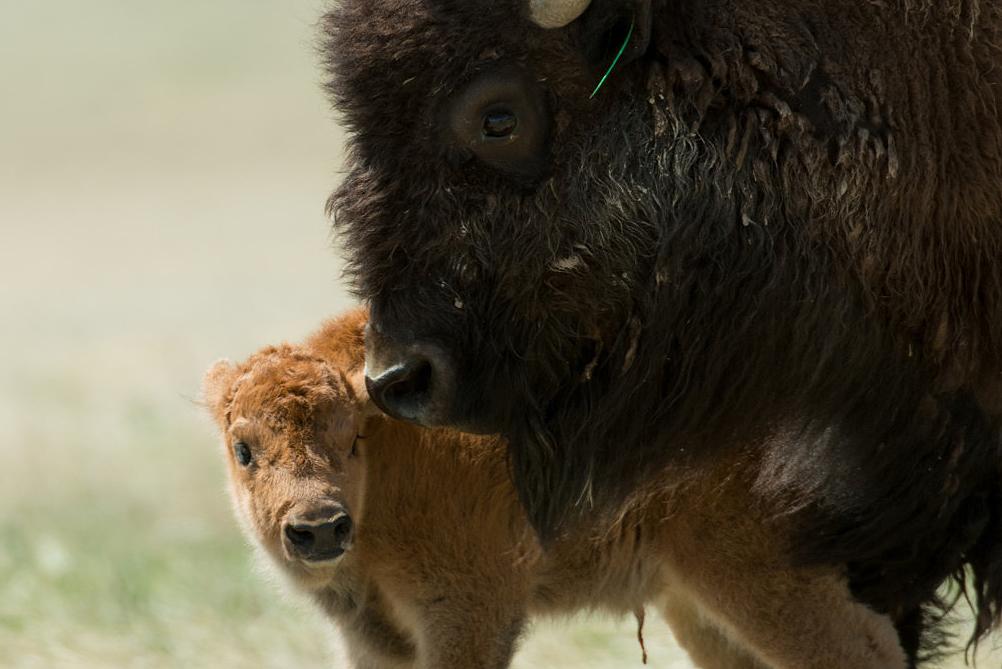
Some bison calves born recently in Northern Colorado represent a new hope for the species. They're the newest members of a herd that is, genetically speaking, as close as any to the iconic animals that roamed the plains before European settlers arrived.
But the herd is also descended from modern-day bison that live in Yellowstone and are plagued with a deadly disease called brucellosis, which is easily spread to other animals.
For years scientists at Colorado State University have grappled with a biological puzzle: how to preserve those historic genetics while ensuring the bison are disease-free and can roam without posing a danger to other animals.
Now they are starting to form an answer. In vitro fertilization and surrogate parenthood -- techniques already used in humans and other animal species -- can be tweaked and used in bison, too. The CSU scientists used those methods to breed a herd at a research facility on campus, and last fall, those animals were released to the plains after ceremonies that included a prayer from a spiritual leader of the Crow Nation and the performance of a Pawnee going-home song.

The herd has grown with the births of five calves this spring -- including the one last week -- the first of what the experts hope will be generations of disease-free bison that can be relocated across the United States.
Colorado Matters host Nathan Heffel spoke with Jennifer Barfield, an assistant professor in the College of Veterinary Medicine and Biomedical Sciences at Colorado State University.
Click the audio player above to hear the conversation, and read highlights below.
On the difference between "bison" and "buffalo:"
"In North America, we call our bison buffalo as well. So use both words to talk about the same animal. Technically speaking, on the scientific term for our animal is "bison bison bison." That's the scientific name.
"But the true buffalo live in Africa and in Asia, but the term buffalo here in North America was really a word that Native Americans adopted when they were learning to communicate with white settlers. And so that name has kind of stuck and taken on a cultural significance for native Americans in North America." (Story continues below video.)
On why the Yellostone herd is unique:
"They have a quite high genetic diversity. And in the history of that herd, those animals have managed to never breed with cattle. And so that's a problem for some herds, but not for the Yellowstone herd. And so what we're doing with our animals is we're helping to bring those valuable genetics out of the park, create a new herd that could then be used to spread those genetics into other bison herds that may need them."
On how they deal with brucellosis:
"Unfortunately, there's no cure for the disease. So it's not that we can bring positive animals here and cure them and get them back out on the prairie. But what we can do is use assisted reproductive technologies, which is a science that allows animals, and people in fact, have healthy pregnancies and healthy babies. We apply some of these embryo technologies to get embryos from these very genetically valuable animals. And then we can put those embryos into healthy bison and allow them to carry the pregnancy, very much like you know a surrogate would carry a human baby for say a woman who couldn't carry her own child."
On how they chose the area near Fort Collins:
"If you go out and visit that site, and you're standing there -- it just feels right. It just feels like those bison should be there for a lot of reasons. We were just really fortunate to be able to partner with the city and the county to put these animals back on the space again."
On the future of the bison:
"There are still quite a few places where bison could roam. For sure, we're never going to see the herds of tens of millions that that roamed here before it was settled by Europeans. But I think there are still a lot of spaces where bison can contribute to the ecosystem and can be a resource even for Native Americans to bring back some of that culture to them."
On why she chose to research bison:
"I was driving down I-25 one day and I saw the Terry Bison Ranch. And I had been learning about all of these techniques in cattle in domestic species. And of course, bison is this really interesting species that sits on that fence -- there's a commercial meat industry, but there's also the conservation side.
"So I just started wondering, 'Gosh, I wonder if anyone has tried to do these things in bison before.' So I started looking into it and there had been a little bit of research, but there was definitely more that could be done. And so I managed to get a hold some ovaries and some semen and I took it to the lab and I made embryos. And I was like, 'Wow. My gosh this works.' "








